—Fr. Raphael, in your works you devote much attention to the temptation of modernism. How do you understand this phenomenon, and what are its spiritual roots?
—Modernism denotes a “new,” “modern” phenomenon. It can manifest itself in art, literature, and religion. The question of modernism in modern Church life interests us. It signifies a rupture with traditional values, concepts, and norms, triggered by the secularization of the human consciousness and a change in moral orientation. In the historical aspect, modernism is a continuation of and new step in renovationism—an anti-Church, avant-garde teaching that arose on the wave of revolution [in Russia] in the first half of the previous century. Then renovationism presented itself as a predominantly ecclesiological heresy, seeking to pervert and destroy the canonical foundations, the hierarchical system, and the liturgical typikon, and immediately manifested itself as a revolt and schism in the Church. Therefore, the boundaries between renovationism and Orthodox traditionalism were pretty clear-cut.
Now modernism acts more cautiously, systematically, and consistently, without loud slogans and excesses, but the scope of its struggle has become significantly wider. If the renovationism of the post-revolution period had little effect on dogmatic questions, then modern modernism digs a deep mine under Orthodox dogmatics, and, what’s most dangerous—speaking against Orthodoxy, and trying to speak on behalf of Orthodoxy, claiming that its only goal is to purify the later accretions to traditional beliefs. The reformism of the modernists may begin with the deformation of form, while allegedly preserving content, and with the deformation of content while at the same time preserving form. In the first case, modernists argue that form is irrelevant, that here we can accept pluralism, that a change or simplification of form can make content more accessible for believers. However, liturgical rituals are the symbolic language of the Church, and the destruction of traditional ecclesiastical forms not only impoverishes, but also deforms the content itself. In the second case, content is changed, while form is temporarily preserved in order to hide the fraud and change in religion. An example of the first—the liturgical and canonical lawlessness of the Renovationists;[1] an example of the second—the false union of Orthodoxy with heterodoxy, where the content of the faith is changed, but the change in form is artificially delayed as a disguise, that the change would not be clear. However, in the end, both content and form are degraded. It must be remembered that content and form in Orthodoxy are closely connected with one another. Content is embodied in certain forms, and form is a constant guardian of content.
—Wherein lies the fallacy in this approach to faith?
—New earthly attitudes towards the spiritual world, and the submissive scale of values cause modernists to desire to bring the dogma, theology, and rituals of the Christian religion to the moral level of modern society. They do not take into account that religion (I have in mind Orthodoxy) is not the product of human talent and even genius, but Divine revelation, given to men, and therefore cannot be augmented and does not need changing. Revelation remains ever the same, not progressing, not evolving, not decreasing, not increasing; it is divulged and communicated to people through the Holy Spirit, acting in the Church. The dogmatic unfolding of Divine revelation occurred at the Ecumenical Councils, which represent the fullness of the Church’s knowledge and are received by the whole Church. The dogma, liturgics, rites, and canons of the Church go back to the initial revelation. This revelation found reasonably deep forms for itself, in which the Divine word was incarnate in the human word, and invisibly received material, visible, and tangible symbol; these forms, inseparable from Tradition, themselves became part of Tradition, and are carefully preserved by Church Tradition and the typikon.
—In fact, it turns out, that modernism encroaches on the very essence of Christianity?
—Precisely. Christianity is the light that stands above the world; it doesn’t allow our semi-pagan world to fully immerse itself in moral and spiritual darkness. Modernists want to commit fraud—to adapt Christianity to human passions, false concepts, and vapid presentations of secularized reason, and to introduce a surrogate for Christianity as a kind of progress, purified from errors, as a Christianity resurrected by them. They say that Christianity must be made understandable to all, and to do that they must conform it to the measure of human reason, so that one might comprehend the incomprehensible by mental power; but Christianity is life in other dimensions. You must join, acquaint, and submit your mind to Christianity through faith, and your senses through purification from the passions of the heart. Modernists propose the reform of Christianity, comfortable for fallen man, promising him the Heavenly Kingdom without asceticism and labor, without a battle against the passions, on the one foundation that God loves man and therefore He will save him. In this consists the appeal of modernism for people of weak will and dulled religious intuitions.
Modernism presents itself as a grand utopia. It is believed in by those who don’t want to part with their passions, those who do not want to really see the possibilities and limits of the human mind, those who are raised in the spirit of humanism and believe that man is a son of God by right of birth, and those who are poisoned by liberalism, to whom Orthodoxy seems not to be the spiritual and moral rebirth of the individual, but a system of prohibitions.
Modernism is the subordination of cult to culture, the spirit to the mind, and revelation to human arbitrariness. Let’s say it more boldly: It is the preference of the earth to Heaven, and of man to God.
—Fr. Raphael, can you point to some concrete features or characteristics of modernism—its distinctive features, so to speak?
—You can point to a whole number of such features. It’s not necessarily that the article or lecture of some modernist will present all the points, but even one is enough to understand that we are dealing with reformism. You don’t have to change all the numbers in a complex formula: It’s enough to change one number, and the whole formula won’t work; one deep wound on a man’s body is enough for blood to flow. Therefore, the errors of modernists enumerated can be contained in any composition, or even be limited to one.[2]
1. Modernists deny the transmission of Adam’s sin to his descendants.
2. They deny the atonement or distort its meaning.
3. They are skeptical towards miracles described in the Bible and in the lives of the saints.
4. They deny the transubstantiation of the Holy Gifts celebrated in the Liturgy.
5. They are hostile to the word “mysticism,” consciously confusing Orthodox mysticism with false mysticism.
6. They strive for language reform—replacing the ancient liturgical language for the modern language, which is less responsive to the dynamics of prayer.
7. They consider the love of God in isolation from the justice of God, thus drawing Divine love into the justification of moral permissiveness.
8. They distort the concept of the Church, namely the dogma of “I believe in one, holy, catholic, and apostolic Church.” They believe that people can be saved in other religious confessions, or even in the absence of any religious faith. They ignore the action of the Holy Spirit Who abides in the Church, and deny the holiness of the Church and the purity of its teachings. They substitute the conciliar consciousness of the Church for their own conjectures and speculations.
9. They try to rationalize theology and worship, generally coldly relating to the services, considering them a secondary matter for salvation.
10. They relate to Holy Tradition, customs, and continuity nihilistically.
11. According to modernists, classical, orthodox theology is nothing more than “spiritual stagnation and boredom.”
12. To hide their anti-Orthodox orientation, modernists affirm in one place that which they deny in another; they deny that which they themselves earlier proved. In this regard, if a modernist is denounced for heretical thoughts, then he refers to another place in his statements and says that his views should be considered not in isolation, but as a whole; but what this whole means is unclear. Modernists resort to such a technique in order to create confusion in the minds of the Orthodox.
13. Many modernists try to rehabilitate the teachings of Origen and almost make him out to be a victim of delusion on the part of Orthodox apologists—the fathers of the Ecumenical Councils. For modernists, Origen is an uncanonized saint.
14. They teach that universalism is pre-determined by God, that is, inevitable. They not only repeat variations of the apokatastasis of Origen, but in some cases go much further. If for Origen the sinner must go through purifying suffering on earth, then some modernists believe it’s enough for a sinner to desire salvation and he will be saved.
15. Modernists downplay the importance of both the angelic and demonic powers in the history of the world and the moral life of every man. They are inclined to write off demonic temptation as emotional effects and mental disorders.
16. Modernists try to discredit Church authorities and religious books.
17. They veer between evolutionary and creationist teachings about the creation of the world and man, and advocate a compromise hypothesis.
18. Modernists use forgery in their critical attacks on Orthodox teaching: Their assumptions are displayed as facts, and their shaky foundations as hard evidence.
19. By assembling quotes and manipulating fragments plucked from Patristic writings, they ascribe to the holy fathers those opinions that suit them, regardless of Church exegesis and the rules of hermeneutics.
20. Modernists, expressing their thoughts, try not to fully reveal them, so as not to betray their anti-Orthodox nature. Therefore, modernists feel the fragmentation and incompleteness of conceptual views.
21. Modernists’ deficiency of faith is disguised as broadmindedness. They speculate with the words “science,” “education,” and “progress.”
22. Modernism not only indulges human passions and worldly tastes, but sometimes even comes to a cynical attitude toward sacred objects. They speak about metaphysical problems with jokes and grins that destroy the sense of awe towards faith. Divinity is a fire, to which it is impossible to draw near without repentance and awe. Some theologians act as if they want to borrow the glory of Mullah Nasreddin.[3]
—What is it that propels a Church person to become a modernist?
—What propels him is that which the Gospel warns us about: pride of the mind, lust of the flesh, and the temptations of the world, with its semi-pagan spirit and the cult of pleasure. It’s the desire to combine the incompatible: holiness and sin, love for Christ with the lust of the world, the Church with the Tower of Babel, Divine revelation with limited concepts and ideas stricken with pride, under the influence of the passions and the egotism of human reason. It is the desire not to submit to revelation, but for revelation to submit to you; it is an attitude towards Tradition as to raw material from which you can sculpt any form and which you can interpret in conformance with the voice of your own passions and desires. In the words of the secular poet: “The white rose with the black toad I wanted to marry in the land.” The thrust of modernists’ thinking is directed towards the earth and is subject to history. For them, religion is not a revelation of eternity in time and a path towards it, but one of the guarantees for earthly prosperity.
—Why is this temptation so great in our time?
—Our time is an era of social and moral revolutions that stun the world. There is a growing process of revision and reformation in all spheres of social, cultural, and moral life, altering morality, breaking worldview conceptions, breaking human relationships, causing catastrophic family breakdown, and the emotional cooling off of people for one another. There is a defilement of morality and an apology for sin through art, literature, and the media. Morality and chastity are seen as opposed to nature, which avenges them with neuroses and phobias. Television shows are turning into injections of debauchery, cruelty, and pride. People’s consciousness is becoming more and more secularized. The permissiveness of lust develops parallel to the permissiveness of the mind (as the mind is identified with one of its powers—reason). As a result, man’s religious intuition is blunted, and his spirit goes into itself and remains as if in a lethargic dream, in a state that can be called neither life nor death.
But there remains in the soul of man some feeling of the mystery of eternity, which neither positivism nor atheism can grant. Therefore, man does not completely sever himself from religion, but looks for compromises that would give room to his intellectual lawlessness, and not hinder the lusts of his soul and body, and at the same time would, to some degree, satisfy his religious sensibilities. The general decline of spirituality was a breeding ground for modernism, which promises to create a new, lightened for the will, comfortable for the passions, unfettered by dogmas and canons for the pride of mind liberal and humanitarian Christianity. In this case, a person can go to church and say his prayers, and at the same time do yoga and meditations taken from the East, be a regular at rock concerts, participate in the creation of monastic literary and sports clubs, and in all this consider himself an Orthodox Christian, of course calling himself not a slave of God, but a son of God.
The Gospel teaching and high ideals of Christianity seem to such people not native and natural to their souls, but some unattainable, beautiful abstraction, which is impossible to implement in life, and sometimes an assault against human nature, which responds to this coercion with painful complexes and pathologies. Modernists seek to replace asceticism with the pleasures of fallen human nature; in this sense it is an apology for the passions and a means of fitting them under Christianity. Modernists want to create a unified Christianity, where the good peacefully co-exist with the evil, to replace the Logos of Christ with the logos of Heraclitus. One of the most prominent decadents wrote, “I want that my boat sailed everywhere, and the Lord and the devil both I am ready to glorify” (Bryusov).
In our time of moral degradation and the legalization of what was previously considered a perversion and disgrace, to live in a Christian manner is already a podvig. Morality is one of the organic elements of religion. With its fall, religion stops being the inner life of man and moves to the periphery of his consciousness. Here there are several possible paths of outcome. First is the struggle for morality and the opposition to the temptations of the world, as to a concentrate of passions, and an atmosphere electrified by lust, pride, and egocentricity, in which man lives.
The second path is Gnosticism and skepticism, as a system of denial, as a comfortable way to escape his own conscience and reflections about the meaning of human existence, while religious teachings and moral principle are perceived as relativistic concepts.
The third path is the satisfaction of warped mystical feelings through Eastern pantheistic religions and occultism. The fourth path is liberal Christianity—a compromise between Christianity and the world, which removes moral responsibility from man. This Christianity is not spiritual joy, but a good mood. It’s like a medicine that does not heal, but reassures the ill that he is healthy, hiding from him that his innards are decimated by cancer. It’s a Christianity with a goose on the spit in Lent and concerts in Holy Week; a Christianity where Heaven and earth change places.
The Gospel is not from the world, but from Heaven—it is the voice of eternity, which opens to us that man himself is created for eternity. The Gospel convicts the world in its sins, and therefore the world hates Christ and His followers.
Modernism is a workshop for the production of false christs, the stainer’s cauldron, in which you can dye Church robes in any color. Modernism has no academic, cultural, or theological foundations. It’s a white flag, thrown in front of the aggression of secularism. However, it corresponds to the sentiment of a significant part of society and they accept it without reasoning; they accept it because they want, instead of harsh realities, to believe in a rosy utopia.
—There is now among some Orthodox a very common skepticism in relation to Church traditions, liturgical traditions, and even this or that dogmatic point. Moreover, this skepticism is quite aggressively promoted as “scientific,” as “enlightenment,” even as “honesty.” What can we say about this phenomenon?
—The forerunner and unchanging ally of modernism is humanism. It’s an inverted scale of values, where the highest place is occupied by empirical, unregenerate, sinful man. Humanism is not only the preference of man to God, but the enslavement of the Godhead by man. Proud human reason denies and rejects sacred Tradition, tramples it, and mocks it, as a victor tears the loser’s banner to pieces. The nihilistic attitude to religion is cloaked in the vague and amorphous term “scientific.” A rupture between the past and present occurs in modernism. Faith shifts to God-building, and ecclesiology to church-seeking. The so-called “scientific method,” applied to religion, is a series of negations that gives nothing and leaves behind it, in place of Tradition, an empty hole. This method destroys all hard criteria of truth, and ignores the presence of the Holy Spirit in the Church, Who vivifies and preserves the Church. Here the Church is replaced by a panel of scientists, most often with a dulled faith and a bloated ego, who look at the Church with its traditions as on a wasteland where they can construct any building.
The scientific method, applied to religious consciousness, degenerates into criticism. All that belongs to Tradition passes through the filter of human reason, unable to understand spiritual phenomena, that is, the supernatural world. A different, uncharacteristic method of checking truth is imposed upon religion (if in the technical and applied sciences the experiment serves as the basis of the scientific method, then religious experience, which involves grace, is not repeated in the programmed experiment). The information extant in literature and material monuments is subjected to doubt by modernists, and objective reliability is replaced with personal tastes and concepts. The facts pass through a meat grinder of criticism, and their remains are tailored to a specific system, which is a faux installation. They base on selected facts and their own imagination theories that are incompatible with and contradictory to one another. Usually the theory first arises, and then the factors are ferreted out and this is all done under the guise of science. We can say that the scientific method, used in modernist circles, is the principle of causality, that is, randomness (randomly surviving manuscripts, randomly found plates with inscriptions, and so on), connected with unbridled science fiction. Thus, before our eyes, scientific theories and hypotheses emerge, develop, change, and are destroyed.
The property of tradition is steadfastness and self-identity; the property of the scientific method is naked rationalism, and the construction of ethereal theories, which arise and die, as the flame of fireworks are ignited and extinguished. But this “scientific method” has psychological foundations in a significant part of modern man, namely, the unrestrained faith in human reason as a universal instrument for cognition of truth, the distrust of spiritual phenomena, and the desire to explain them by material causes. Figuratively speaking, this is a verification of metaphysics through physics, the world of the infinite and finite through limited human reason. We can say that the scientific method applied to religion is the sphere of fantasy and rationalistic nihilism.
—What are the causes of this phenomenon?
—The impoverishment of faith produces a vacuum in the soul and man tries to fill it with reformism, false interpretations and a critical approach, which is a pseudoscientific substitute and eclecticism. Here a handicap is issued for elitism and intellectualism.
We must remember that the Church is the pillar and ground of the truth and all that does not find confirmation in Church teaching is doubtful, and what contradicts it is a lie.
We must also remember that Sacred Tradition was not developed from Patristic texts, but has existed in the Church from the beginning; it finds its expression in Patristics. Here the grace of the Holy Spirit has selected and preserved all that is consistent with spiritual truth. The four Gospels were taken and separated from other inauthentic or distorted versions of the Gospel—such as the Apocrypha—and those texts preserved by the Church. If Church Tradition did not exist, then the boundaries between God-inspired Scriptures and the Apocrypha would be blurred. At the Ecumenical Councils, the holy fathers, in confirming Orthodoxy, turned first of all to Sacred Tradition. Thus, the dogmas, adopted by the Church, always existed within it, and at the Ecumenical Councils they were simply crystallized from Tradition.
Church worship also goes back to Apostolic Tradition. Modernists reject that which has been received by the Church, and substitute conciliar thinking and Sacred Tradition for the chaos of ephemeral human opinions.
—Fr. Raphael, how would you advise those Orthodox who are faced with such phenomena of modernism and skepticism; for example, students who might hear such things in class?
—I would advise to critically relate to scientific criticism, which discredited itself already in the anti-Biblical, “comparative-historical school” of Bauer-Strauss, and to relate with distrust to those who do not trust Sacred Tradition, having received and receiving a mass of confirmation in archaeology and archaeography. To those who want to seriously study Orthodox theology, they should carefully study classical theology—the works of the theologians of the nineteenth century,[4] and first of all the Patristics. The relation of classical theology to contemporary modernism is difficult to provisionally compare with the relationship of classical music to modern rock music and heavy metal. We must engage in internal prayer, especially the Jesus Prayer, which makes not only the mind, but the heart Orthodox, and man to begin to feel the continual dissonance and hypocrisy in the works of modernists contemporary to us.
—Is there a general “cure” for modernism?
—The medicine is humility of mind and chastity of soul. The ancient sages have already said, “Man is what he eats,” meaning not only physical, but also spiritual and intellectual nourishment. In order to preserve Orthodoxy of the mind, man must be prudent about the books he reads. The wise Solomon says, Drink waters out of thine own cistern, and running waters out of thine own well (Prov. 5:15). This cistern is the works of the holy fathers, and the well the Church. To guard your mind not only from modernism, but from a variety of deceptions, including occultism, you must preserve your soul from sinful images and alluring temptations of diabolic emanation, which, being willingly accepted by man, perverts his senses, pollutes his memory, and sways his thinking. If a man preserves his chastity of soul, then his religious intuitions, as an internal voice, will tell him where is the truth, and where lies.
—In your observations, what are the greatest dangers in the spiritual life waylaying an already Churched man? How to escape them?
—A Christian, especially from the beginning of his Church life, unwittingly identifies the Church with the clergy. Therefore, a bad example of a clergyman, his unbecoming actions, and even rumors of his vices can become a reason for distrust and disappointment not only in relation to the given clergyman, but to the Church itself. The clergyman should always beware of tempting his flock by word or deed. He teaches not only by preaching, but by the example of his life. If the example is bad, then no preaching can help.
Another reason for cooling is the feeling of loneliness and irrelevance in the Church, when the priest is not interested in the spiritual life of his parishioners, when they are distant from one another, and when the parish is not a spiritual family.
There is one more reason, especially dangerous for intellectuals—the desire to receive all the spiritual gifts immediately. Pride, arrogance, confidence in the power of his reason, and elitism as the chosen can engender instead of Christian mysticism, based on humility and obedience, a false, perverted mysticism. Therefore, we need guidance in the spiritual life; if you have no mentor, then at least consult with older and more experienced people. Man must begin the spiritual life with repentance and cleansing from sin. Those who think about receiving the gift of Divine love without this—of which many speak, but few have—are like a man who tries to build his house beginning with the roof. Gradualness and consistency are absolutely necessary in the spiritual life; here personal conjectures and findings that seem like spiritual insights are dangerous.
—Why do active Church people experience a cooling of their faith? Is it possible to rekindle the faith in their souls?
—A cooling in faith happens when someone lives not according to the Gospel commandments, but according to the passions, when he confines himself only to the performance of rituals, and forgets about purifying his heart from sin, when he thinks that he can comprehend the mystery of faith by some power of his mind and not the podvig of an entire life, especially prayer and repentance. The holy fathers say that grace returns through the same door it left. You have to work out with the help of your spiritual father why your faith cooled and what errors you allowed. Faith enlightens the mind through dogma, and the heart through worship, and participation in the sacraments and home prayer, and it strengthens the will through fulfillment of the Gospel commandments. Often cooling happens due to the abbreviation, and then the abandonment of the prayers necessary for a Christian. St. Theophan the Recluse therefore gives the instruction, “Besiege yourself with rules.” These rules should include the morning and evening prayers, the reading of the Gospel and apostolic epistles, and also the Psalter. It’s better not to make a rule yourself, but to follow the instructions of your spiritual father or the parish priest to whom you confess.
We must know that there are periods of providential cooling in a man’s life, as if being forsaken by God, in order to understand that we can accomplish nothing by our own strength without grace, except for sin. It’s a lesson in humility that we must remember our whole lives.
There is another reason for an apparent cooling: Grace acts especially clearly and strongly in man’s soul at the beginning of the spiritual path, as if carrying him on wings; but then, according to the measure of spiritual growth, grace as if recedes, that man would not be lazy, that his will would all the more participate in his spiritual life. In such inevitable periods, he must not fall into despondency, but continue to pray and go to church.
—How would you advise those who undertake to speak publicly about theology or the spiritual life?
—I would advise them to consult with their spiritual father and take his blessing, and if your spiritual father has no time to read your works, then give them to be read to someone versed in theology, with the correct spiritual orientation.

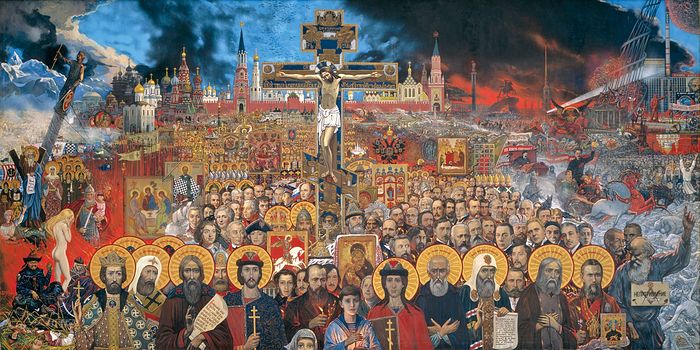
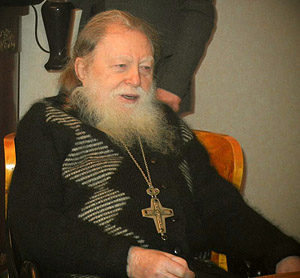
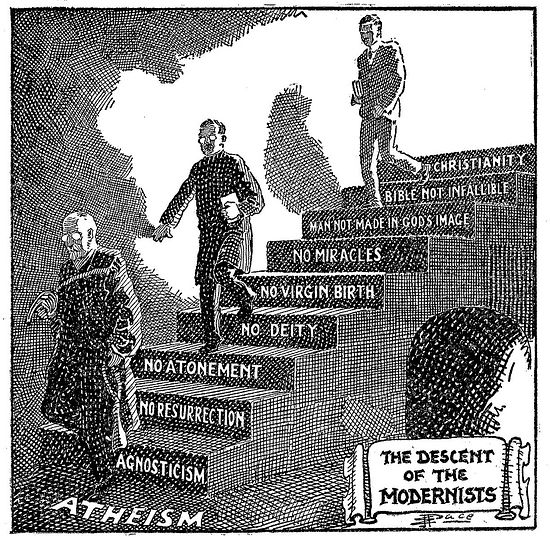

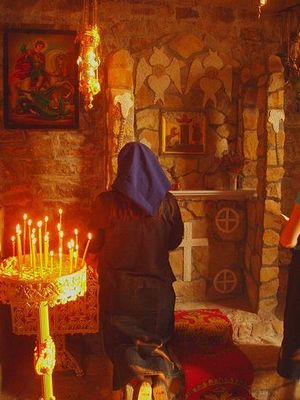
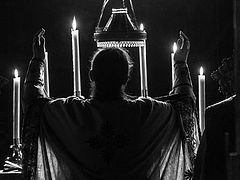
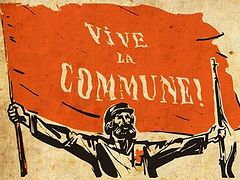
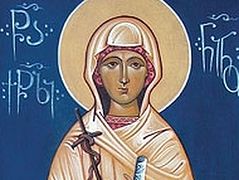
I would like to bring up a seeming MINOR point but a profound one and that is the greek american, now spread to korea and Albania, use of organ and harmonium in a very old fashioned 19c way actually.
Some will say a MINOR point but as psychologist I DISAGREE totally. Anyone who has attended this type of worship sitting in his or her pew, neither USING THE BODY in prayer by prostration, etc, treated like a Theatre goes and the distotion of the primacy of the word and destruction of that traditional Orthodox liturgical beauty,will understand the spiritual change that goes on in one's soul..as priestly look.
ZzzZzZzzZzZzZzz
[Indeed, they have an unbreakable faith in the idol they call “science”. They question everything, from the Scripture to the words of our Lord to the holy tradition of the Fathers in the Church, but every idiocy uttered by the scientist idol through its pathetic oracles is taken by them at once as sacred dogma. All of them believe firmly to live upon a mad ball, blessed by democratic progress sculpted in unfailing love for the unrepentant, wandering aimlessly in a demential universe. They are the fullest fulfilment of the prophecy of St. Anthony the Great!]
Again what this article says about morals - straight and to the point. Another most beloved priest from the west whose writings grace the pages of this website all too often loves to pontificate ad nauseaum about about sin not being a ''moral problem'' and other such nonsense.
This article is all-encompassing of genuine Orthodox Christianity, and sets the record straight. Wonderful stuff.